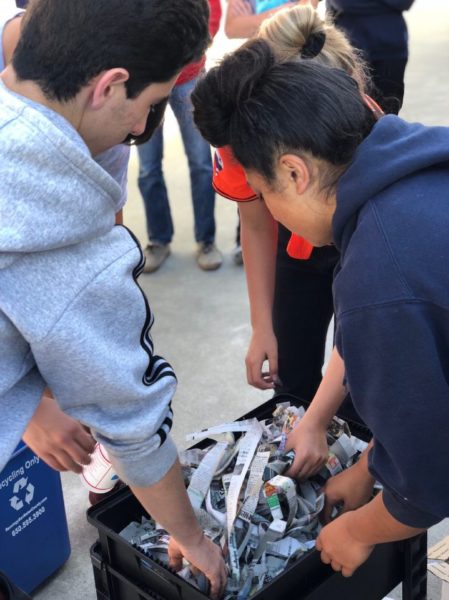
Students get hands-on experience of composting.

Waste Reduction worker from San Mateo’s Office of Sustainability, Gerald Schwartz, came to speak with the AP Environmental Science class on Thursday, Nov. 1 during third and fifth period.
Students in the AP Environmental Science class learned how matter, carbon, hydrogen, phosphorus and oxygen are part of an ecosystem. Schwartz brought red wiggler worms to illustrate the decomposition process and the cycling of nutrients.
“The worms are helping break down the matter [which] returns to the soil,” said AP Environmental Science teacher Jessica Valera. “I thought it was a great hands-on way for students to have a experience with a small contained ecosystem.”
The Office of Sustainability focuses on teaching communities to adapt to the constant changing environment by supplying new ideas or solutions that can benefit both the community and each individual.
“Anything to do with sustainability and also livable communities is a part of our department,” said Schwartz. “We have folks working on policy for, for example, sea level rise [and how] to prepare cities in San Mateo County … We also have like a green business program where we’re promoting businesses to conserve water and to conserve energy and also to reduce waste.”
Schwartz works in the Waste Reduction facility, so he spoke about worm composting, which is a new efficient way to compost organic foods. Worm composting involves a bin with a layer of fungi and bacteria, a layer of wet paper towels and red wiggler worms.
“The worm composting system it’s a very actually easy way to convert organic waste to from leftover fruits and vegetables into compost itself,” Schwartz said. “It’s a really great example of how stuff can be broken down and basically recycled and be made into nice rich nutrient-rich soil for plants to grow.”
This at-home way to compost benefits gardeners, since worm composting provides fresh compost that can be mixed with soil and instantly used. Students in both periods prepared bins with Schwartz that will be kept in Valera’s classroom to see how this composting system works over a couple of weeks.
“We’ve put organic waste like apple cores, banana peels and different plant waste and they are breaking down and we use the compost that they’ve created and mixed it with other soil to have nutrient dense soil to grow plants in for other projects we are doing,” Valera said.
After the presentation students used microscopes to get a better view of the red wigglers and their environment.
“I think we’ll gain a new understanding of the little things we can do to reduce carbon emissions,” said senior Isabella Young. “Interactive learning is a great way to better understand what we are currently doing to our planet and how we can better our situation because reversing or slowing the effects of climate change is a very personal thing.”
With the bins students are able to get a first hand experience of what the composting process looks like and its benefits.
“I think it’s interesting how the whole process of breaking down and how waste turns into soil,” said senior Caitlin Zhang. “Usually it’s hard to imagine how something like a fruit can just become clumps of dirt but then if you can see the worms do it then maybe you can learn the whole process of breaking down.”
With this presentation, Valera hopes that students will have a better understanding of the composting process and may even consider to start their own worm bin at home.
“It’s awesome to expose students to how we can make a difference in how the waste us humans produce and how it’s broken down and making sure that it doesn’t go to landfill,” Valera said. “Just getting a few students interested in this type of thing or getting a few students wanting to do a worm composting bin at home or being more aware of their decisions [is] completely worth it.”



